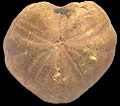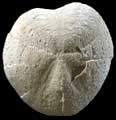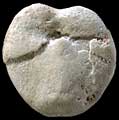The Echinoid Directory
Mariania Airaghi, 1901, p. 211
[=Airaghia Lambert, 1910, p. 3 (nom. van.)]
| Diagnostic Features |
|
|---|---|
| Distribution | Miocene, France, Corsica and Sardinia. |
| Name gender | feminine |
| Type | Macropneustes marmorae Desor, in Agassiz & Desor 1847, p. 9(115), by original designation. |
| Species Included | Lambert & Thiery (1921, p. 444) list two other possible species as congeneric.
|
| Classification and/or Status | Spatangoida, Micrasterina, ?Maretiidae. Unknown. |
| Remarks | This taxon differs from Spatangus in having and elongate, wedge-shaped labral plate and short sternal plates. Furthermore in Spatangus the episternal plates do not markedly narrow to the rear whereas the episternal plates of Mariania are quite strongly indented to the rear by ambulacral plate 6. Philippe (1998, p. 213) regarded Mariania as a subgenus of Spatangus, but the labral plate is very different in shape and extend, extending to the rear of ambulacral plate 2 in Mariania. Both Philippe (1998) and Kroh (2005) give detailed descriptions of Mariania deydieri (Cotteau). It seems likely that it belongs to the Maretiidae rather than the Spatangidae given its plastron structure. Cotteau, G., in Locard, A, 1876. Description de la Faune des Terrains Tertiaires moyens et superieures de La Corse. Annales de La Societe d'Agriculture Histoire Naturelle et Arts Utiles de Lyon 9, 4, 3-380 pls 1-27 Cotteau, G. in Loccard, A. 1877. Description de la faune des Terrains Tertiares moyens de la Corse. F. Savy, Paris. Cotteau, G. 1884. Paleontologie Francaise. Terrains Tertiares II, Echinoidea Eocene. V. Masson, Paris. Kroh, A. 2005. Catalogus fossilium Austriae. Band 2. Echinoidea neogenica. Verlag der Osterreichischen Akademie der Wissemschaften. 210 pp., 82 pls. Philippe, M. 1998. Les echinides Miocenes du Bassin du Rhone: revision systematique. Nouvelles Archives, Museum d'Histoire Naturelle de Lyon 36, 1-441. |








